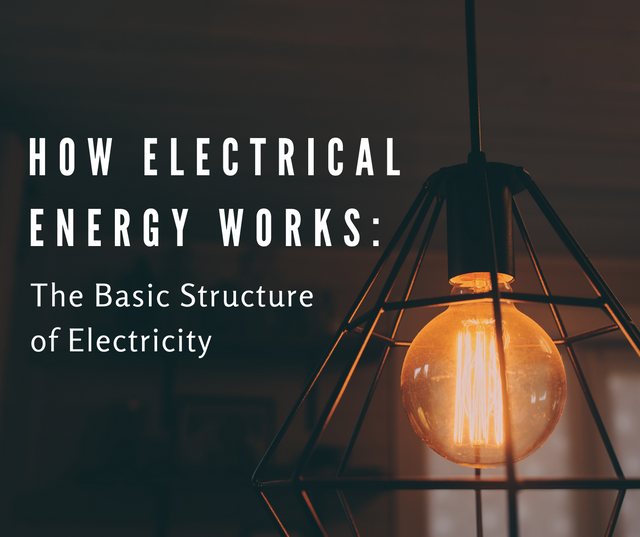Electricity is a fundamental part of our daily lives, providing both illumination and power to the world's billions of inhabitants. People have long been fascinated by electricity — from its bizarre manifestation as lightning, to its routine appearance in household appliances. How does the electric current actually function inside an appliance, though? This diagram should help.

The Basic Structure of Electricity
The simplest way to visualize electricity is as a flow of electrons from a negatively charged area located inside an atom (the nucleus) to an area outside the atom that contains more electrons, such as a metal surface or other electrical conductor (the electron cloud).
An electron cloud can be thought of as an atom's nucleus. The innermost orbit contains most of the electrons, and the outermost one is empty. However, these orbits aren't circular — they're elliptical:

Source: wikimedia License: CC BY-SA 4.0
When an electrically charged particle passes through this flow of electrons, the flow of electrons changes direction. You've probably seen that happen in cartoons. For example, imagine a positive charge (which is like having a positive battery inside your atom) moving across a wire that has drawn negative charges towards it. The negatively charged charge would hit the top part of the wire (the negatively charged area), and then jump over to the bottom part of the wire, creating a "charge imbalance" that would make a colorful blob appear on your TV screen or cell phone screen (the electrons on one side suddenly move where they don't belong).

Source: freeimg.net License: CC
Electrons in atoms have their own orbits, just like planets have their own orbits around the sun. If a planet is only slightly closer to the sun than its closest neighbor, the two planets' orbits will intersect with each other. This causes them to repel each other, as if they were magnets with similar poles. However, if one of these planets were pushed even further out into space (what we call a "trailing orbit"), it wouldn't encounter another planet nearly as often, and would be able to go about its business quite peacefully.
Electrons are very similar in this respect. Sometimes, two electrons that are very close together can be pulled away from their host atoms and drift off into space together. This is called an "electric current".

Source: wikimedia License: CC BY-SA 4.0
When you pass a wire through a magnetic field, you cause the electrons to flow. The electrons are naturally attracted to the areas of space around them that have more electrons, so they move toward the positive areas of the field. When they do this, a negative charge is created on one side of the wire and becomes a positive charge on the other side. Since opposite charged particles attract each other (like magnets with different poles), these charges shoot off in opposite directions.

Source: wikimedia License: CC0 1.0
This is how electricity actually works: When you give something extra electrons (positively charged), it moves them towards negative areas or places that have fewer electrons (nations that are less full). When you give something fewer electrons (negatively charged), it moves them towards positive areas or places that have more electrons (nations that are more full).
Conclusion
Electricity is a must for many modern devices, which have to be powered by some form of electricity. Most people have seen the familiar lightbulb, but few are aware that they wouldn't work without electricity. Other interesting pieces of technology include the clock, TV remote control, cellphone and even a battery-powered watch! Before electric clocks appeared in factories and homes, people used to wind tiny hand-cranked timers up with a key. These devices didn't last long because they ran out of juice after only a few hours! Today, we have our electricity delivered through the wires to our houses - and we sleep soundly at night knowing that our appliances will keep us company for many years to come
For the billions of people who call this planet home, electricity provides light and power in equal measure. When electricity first appeared in the sky as lightning, people were awestruck. Since then, it's appeared routinely in household appliances and other parts of daily life. Exactly how does electricity work within a machine is the real question. Using this diagram, as a point of comparison, here it is.
Thanks for amazing introduction @tarpan
Downvoting a post can decrease pending rewards and make it less visible. Common reasons:
Submit
Hello @tarpan , your post have been supported by @reminiscence01 using @steemcurator07 account.
Downvoting a post can decrease pending rewards and make it less visible. Common reasons:
Submit
Hello, Sir
Three days have been passed but my introduction post isn't verified. Is there any problem?
My Introduction Post : https://steemit.com/hive-172186/@itz-sohan/achievement-1-my-introduction-post
I request you to take look. Thank you.
Downvoting a post can decrease pending rewards and make it less visible. Common reasons:
Submit
Upvoted! Thank you for supporting witness @jswit.

Downvoting a post can decrease pending rewards and make it less visible. Common reasons:
Submit
nice information shared by you about electricity Also it is very interesting for reading thanks for sharing with us and stay connected.
Downvoting a post can decrease pending rewards and make it less visible. Common reasons:
Submit